May 1, 2002
Dear Family and Friends,
The hummingbirds came early this year. Mid–May is their
usual time, but they’ve been flying around for a week asking that we put out the feeders.
They are prolific already, though at most they have probably made nests
and perhaps laid their eggs. Their arrival is a harbinger of warmer weather
which, with a few notable exceptions, has been the norm for most of the
time since last October. I reread what I wrote last year at this time and
for at least the second year in a row, winter has gone elsewhere, leaving
Nederland in a sort of tepid funk: just barely enough snow for the skiers
to have a short season on the slopes but required that we burn no more
than a cord of wood. Our woodpiles are good for another two or more years.
And at our age, as Martha Stewart would say, that’s a good thing.
but they’ve been flying around for a week asking that we put out the feeders.
They are prolific already, though at most they have probably made nests
and perhaps laid their eggs. Their arrival is a harbinger of warmer weather
which, with a few notable exceptions, has been the norm for most of the
time since last October. I reread what I wrote last year at this time and
for at least the second year in a row, winter has gone elsewhere, leaving
Nederland in a sort of tepid funk: just barely enough snow for the skiers
to have a short season on the slopes but required that we burn no more
than a cord of wood. Our woodpiles are good for another two or more years.
And at our age, as Martha Stewart would say, that’s a good thing.
These past few months have not been without some
notable changes. Hughes began receiving social security. Not much to be
sure, but like a drivers license, taking a first legal drink, voting for
the first time, or saying good–bye to the last pimple, it marks a rite
of passage from one stage of life to another. On his birthday, we drove
to Rocky Mountain National Park and plunked down a ten dollar bill for
a Golden Eagle pass, a lifetime of free entrance to national parks, monuments,
and other federal sites. That and 25¢ coffee at MacDonald’s and lower
airfares on some airlines are but a few of the small compensations for
hanging on for 62 years.
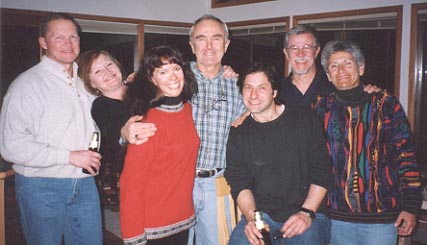 Judy’s
birthday ended in a zero this year, which meant that she not only became
the youngest in a new runners age group at races, but she was also entitled
to a surprise birthday party which neighborhood friends pulled off. All
Hughes had to do was get her to the party place on a plausible pretense
and sneak the cake in. She was truly surprised, at a loss for words for
a while, and spent the evening grinning a lot.
Judy’s
birthday ended in a zero this year, which meant that she not only became
the youngest in a new runners age group at races, but she was also entitled
to a surprise birthday party which neighborhood friends pulled off. All
Hughes had to do was get her to the party place on a plausible pretense
and sneak the cake in. She was truly surprised, at a loss for words for
a while, and spent the evening grinning a lot.
We both spent a good deal
of the winter helping the Chamber of Commerce create and produce the first
Frozen
Dead Guy Days festival. Though many of you read about it in your newspapers
or saw a brief report on the news around March 9–10, the underlying significance
of the event may have escaped the analysis of your local reporters.
Here’s the real scoop: Yes,
Bredo Morstel is safely ensconced in a metal coffin surrounded by large
blocks of dry ice inside a 8' x 10' Tuff Shed on the hillside property
still owned by his grandson, Trygve, who hopes that someday medical technology
will be able to restore “Grandpa Bredo” to his former self and thus gain
a measure of immortality. (If you think that’s crazy, then Walt Disney
and a host of others are similarly “tetched.”). Grandpa Bredo has been
on ice in Nederland since 1990; he is considered the best of neighbors:
never complains, avoids loud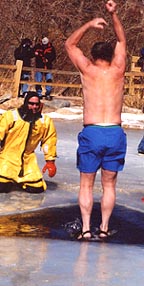 parties, has few visitors, never utters an unkind word about anyone, pays
his taxes and minds his own business. Folks kind of forget about him most
of the time.
parties, has few visitors, never utters an unkind word about anyone, pays
his taxes and minds his own business. Folks kind of forget about him most
of the time.
Given that winters in the
mountains can be hostile and not inviting to travelers except those hardy
souls who like to ski and snow shoe into the teeth of fierce winds, and given
that businesses generally see a decline in revenue during the winter, the
Chamber decided to encourage folks to enjoy our fair city during the winter,
drop a few bucks around town, and pay honor to a fellow who never saw Nederland
(Grandpa was born, raised, lived, and died in Norway; it was his Grandson
who brought him over), and have a good time on a March weekend that could
have had three feet of snow and blizzard–like conditions. Such was not
the case this year: we had clear deep blue skies, temperatures in the low
30s and winds over 50 miles per hour. An enterprising fellow could have
paid for a Caribbean vacation selling knit hats and scarves to the out-of-towners
if he had planned ahead.
What folks also witnessed
were coffin races, fools who jumped through the hole cut in 16" of ice in
the town lake (Yep, on the right that’s Hughes about to make the jump with
Judy in her fire department dry suit ready, if necessary, to rescue and
resuscitate him), a Grandpa Look Alike contest, an all-you-can eat pancake
breakfast, and a special showing of the movie classic “Grandpa’s
in the Tuff Shed,” winner of several awards at film festivals
around the country. The two days warmed the coffers of most businesses
and the hearts of visitors who knew they were right about the quirky nature
of the residents of Nederland. Who the hell in their right mind would jump
into icy water in freezing weather and a wind chill of well below zero?
Grandpa, the frozen dead guy, gets to have the last laugh.
Speaking of cold, one of
our winter trips was to Elko, Nevada,
to attend the National Cowboy Poetry Gathering, sponsored by
the Western
Folklife Center. It’s sort of first cousin to the National Storytelling
Festival we often went to in Jonesborough, Tennessee. The weather, as you
might imagine, was cold; we knew it would be cold; we prepared for the
cold; but we didn’t know it would be so cold: 10° below zero at night
was the warmest, 25° below was the worst. It never got above 20 during
the day, and the sun often shown.
All the events were either
in the town’s convention center or across the street at the junior high
school gymnasium. It was four days of great cowboy poetry and music (not
country, not bluegrass, but pure cowboy stuff) that we came to thoroughly
enjoy. We looked forward to some favorite performers we’d heard before:
Ian Tyson (of Ian and Sylvia, a popular 60s folk duo), and Baxter Black
and Waddie Mitchell, two buckaroos who brought cowboy poetry to a national
audience. But every day, every performance, we heard fine performers we’d
not known before who rivaled those three, including two award–winning Australian
performers who reminded everyone how similar Australian cowboy traditions
and narrative poetry are to what we have in this country. (You can hear
many of this year’s performers online by logging on
to The
18th National Cowboy Poetry Gathering and clicking “Listen”). The event
and what the performers honor represent a slice of American culture of
which we had only a tiny notion before going. It’s worlds apart from Boston,
the midwest, the West Coast and other places we’ve lived. If you’ve not
attended, it’s a fabulous experience. Unless you’ve been, it’s hard to
understand why thousands of folks come from all over this country and Canada
(and Australia) to be part of it.
Last month we drove
to Sedona,
Arizona (about 30 miles south of Flagstaff) for a week of winter R
& R. We’d planned the trip back in the fall in anticipation that April,
one of our snowiest months, would be a good time to escape to a warm, dry
area. We did have warm dry weather the whole time we were gone. We planned
not only to hike and relax in Sedona, but we knew that the area was very
much like the Moab, Utah, area:
red rock formations, slickrock biking trails, great scenery, etc.
On the way, we spent the
first night in Moab, Utah, where we biked briefly on parts of
the Kokopelli
Trail and in the Fisher Towers area. The next day we stopped
at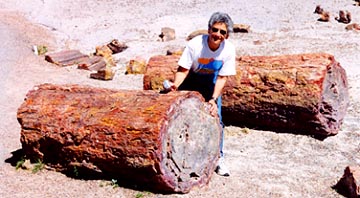 Edge
of Cedars State Park in Blanding, Utah, and saw a surprisingly beautiful
display of contemporary Mata
Ortiz pottery from Mexico (it’s the equal of pottery by the Hopis and
from the pueblos of New Mexico). Later in the day we stopped at
the Hubbell
Trading Post at Ganado, Arizona: a National Historic Site run by the
National Park Service and still doing business as a traditional trading
post. The second night we stayed
in Holbrook,
Arizona, once an important stop on US 66 that still retains much of
the 1950s flavor of that historic
highway: Joe
and Aggie’s Cafe and the Wigwam
Motel still are doing business as they did when US 66 really was the
“Mother Road.”
Edge
of Cedars State Park in Blanding, Utah, and saw a surprisingly beautiful
display of contemporary Mata
Ortiz pottery from Mexico (it’s the equal of pottery by the Hopis and
from the pueblos of New Mexico). Later in the day we stopped at
the Hubbell
Trading Post at Ganado, Arizona: a National Historic Site run by the
National Park Service and still doing business as a traditional trading
post. The second night we stayed
in Holbrook,
Arizona, once an important stop on US 66 that still retains much of
the 1950s flavor of that historic
highway: Joe
and Aggie’s Cafe and the Wigwam
Motel still are doing business as they did when US 66 really was the
“Mother Road.”
The big draw, of course,
is the nearby Petrified
Forest National Park and Painted Desert area to the east of town. We’d
not been before and the half day we spent hiking through and around the
fallen mineralized trees was an amazing experience. Fortunately the temperature
was nothing like the heat of the summer when most tourists come to this
area. There are no trees, no shade, and often folks spend little time really
hiking this desolate but stunning desert area.
But Sedona
was out main destination so after the Petrified Forest stop and another
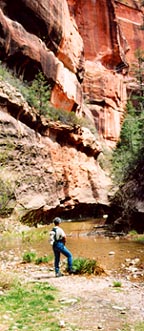 brief
one in Flagstaff, we drove the 28 miles down
beautiful Oak
Creek Canyon to Sedona and Los
Abrigados Resort and Spa, our destination for the next week. Though
we had not seen the resort before, we could not have selected a nicer place
to stay. It features several restaurants, two pools, a comfortable suite
with a tiny but adequate kitchen, fishing in Oak Creek, fitness and spa
facilities for Judy’s massages, tennis and miniature golf (which we didn’t
use) and a short walk to fine galleries. More important were the terrific
hiking and biking opportunities.
brief
one in Flagstaff, we drove the 28 miles down
beautiful Oak
Creek Canyon to Sedona and Los
Abrigados Resort and Spa, our destination for the next week. Though
we had not seen the resort before, we could not have selected a nicer place
to stay. It features several restaurants, two pools, a comfortable suite
with a tiny but adequate kitchen, fishing in Oak Creek, fitness and spa
facilities for Judy’s massages, tennis and miniature golf (which we didn’t
use) and a short walk to fine galleries. More important were the terrific
hiking and biking opportunities.
The area around Sedona is
red sandstone formations with pinon and juniper vegetation, along with
yucca, 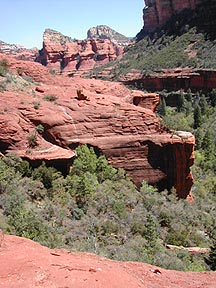 cactus,
sage, and other grasses associated with high desert
areas. Red
Rock State Park seems to surround the town and offers a wide variety
of recreational opportunities, as well as being home to a number
of vortexes
that are the destination of new age believers. (A recent study by Northern
Arizona University reported that 64% of visitors to Sedona came “seeking
some kind of spiritual experience... Vortex sites are some of the most
visited and impacted sites in the Red Rock Country of Coconino National
Forest.” No wonder, then, that several of our hiking and biking destinations
were, coincidentally, to a vortex where we commingled with individuals
or groups meditating. We hiked
the West
Fork Trail, a slot canyon (see photo on right) at the northern end of
Oak Creek Canyon until we couldn’t go any farther without hiking through
the creek, and we hiked the Boynton
Canyon Trail on the north side of town; both of these are quite popular,
both are easy to moderate 5 to 6 mile hikes, and both offer spectacular
views (that’s the view from Boynton Canyon Rim on the left). With over
60 trails within the region, we’ll have plenty of new trails to try out
on our next visits.
cactus,
sage, and other grasses associated with high desert
areas. Red
Rock State Park seems to surround the town and offers a wide variety
of recreational opportunities, as well as being home to a number
of vortexes
that are the destination of new age believers. (A recent study by Northern
Arizona University reported that 64% of visitors to Sedona came “seeking
some kind of spiritual experience... Vortex sites are some of the most
visited and impacted sites in the Red Rock Country of Coconino National
Forest.” No wonder, then, that several of our hiking and biking destinations
were, coincidentally, to a vortex where we commingled with individuals
or groups meditating. We hiked
the West
Fork Trail, a slot canyon (see photo on right) at the northern end of
Oak Creek Canyon until we couldn’t go any farther without hiking through
the creek, and we hiked the Boynton
Canyon Trail on the north side of town; both of these are quite popular,
both are easy to moderate 5 to 6 mile hikes, and both offer spectacular
views (that’s the view from Boynton Canyon Rim on the left). With over
60 trails within the region, we’ll have plenty of new trails to try out
on our next visits.
Bicycling in the Sedona
area is as popular as hiking, though you’d never know it from the lack
of bicycle lanes and narrow shoulders along the roads. To be safe, you
need to cart your bike to a trail head and return to your car when you
run out of trail. We especially enjoyed the 15–mile loop we took from the
village of Oak Creek, just south of Sedona, that followed the easy Bell
Rock Pathway north to the Big Park Loop and Little Horse Trails. What started
out as a hard packed two–lane 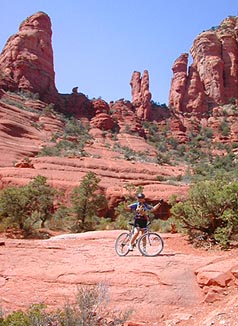 pathway,
went through paved neighborhoods, to jeep roads and finally a fairly challenging
rocky single track that was steep enough is some places that we walked
(or flopped) until we came to less challenging stretches. That’s Judy on
the right posing on the edge of Chicken Rock, the beginning of a two–mile
stretch of tough (we thought) single track and the site of Hughes’s headfirst
flop into an area thankfully without snakes, cactus, or yucca. Like our
hikes, we had sensational weather: April temperatures 65° to 70°,
clear skies, and light breeze. At the end of each, we returned to Los Abrigados
for rest, a massage, a swim, and even some fishing.
pathway,
went through paved neighborhoods, to jeep roads and finally a fairly challenging
rocky single track that was steep enough is some places that we walked
(or flopped) until we came to less challenging stretches. That’s Judy on
the right posing on the edge of Chicken Rock, the beginning of a two–mile
stretch of tough (we thought) single track and the site of Hughes’s headfirst
flop into an area thankfully without snakes, cactus, or yucca. Like our
hikes, we had sensational weather: April temperatures 65° to 70°,
clear skies, and light breeze. At the end of each, we returned to Los Abrigados
for rest, a massage, a swim, and even some fishing.
 One
of the nice things about Sedona is that is is relatively close to quite
a few other interesting spots: the Grand Canyon is within a couple of hours
(we didn’t go). The old mining town of Jerome
that sits atop Cleopatra Hill a mile from the Gold King Mine (copper) was
once the territorial capital, and is within an hour’s drive of Sedona.
Tuzigoot National Monument, Montezuma’s Castle National Monument, and Montezuma’s
Well (all built and inhabited by the Sinaguan people, contemporaries of
the Anasazi) are also within an easy drive.
One
of the nice things about Sedona is that is is relatively close to quite
a few other interesting spots: the Grand Canyon is within a couple of hours
(we didn’t go). The old mining town of Jerome
that sits atop Cleopatra Hill a mile from the Gold King Mine (copper) was
once the territorial capital, and is within an hour’s drive of Sedona.
Tuzigoot National Monument, Montezuma’s Castle National Monument, and Montezuma’s
Well (all built and inhabited by the Sinaguan people, contemporaries of
the Anasazi) are also within an easy drive.
Any description of Sedona would not be complete
without some mention of jeep trips through the Red Rock Country, particularly
in pink jeeps, one of Sedona’s best
known “landmarks.” There. I’ve mentioned them.
We spent a February week
at our favorite Mexican resort, The Krystal in Puerto Vallarta, with daughter
Debra, son-in-law Dan, and grandchildren Griffin and Julia. We swam in
the resort pools, won tequila and other prizes playing bingo, took a day
trip to see whales and to snorkel, read lots of books, and ate at some
of our favorite restaurants and discovered one new great place to add to
our list of favorites. Dan and Hughes went to a bullfight—read James Michner’s
Mexico
to understand why—and left before the end. We really enjoyed being with
both Deb and Dan, and we especially were glad to be with Griffin and Julia
who grow before our eyes, though we see them too little because of distance.
It was a wonderful family vacation week together. We added a
brief “Postcard
from Puerto Vallarta” to our web site.
So, spring is here, the hummers have returned from
their winter homes in Mexico, the snow has melted below 10,000', and our
pasqueflowers and daffodils are in bloom. It’s a nice time of the year
to clean the garage, wash the windows, and work in the gardens. We leave
in a couple of weeks for Boston to stay with the grandchildren while Debra
and Dan vacation in Ireland (They’re staying at
Ashford Castle in Cong,
County Mayo, where John Wayne pretended to be Irish in “The
Quiet Man.”). When we return, we’ll have just a couple of months
to get ready—especially physically—for our Kilimanjaro climb in July and
August. If we make it, we’ll write another Friends and Family letter then.
Wish us well!
 but they’ve been flying around for a week asking that we put out the feeders.
They are prolific already, though at most they have probably made nests
and perhaps laid their eggs. Their arrival is a harbinger of warmer weather
which, with a few notable exceptions, has been the norm for most of the
time since last October. I reread what I wrote last year at this time and
for at least the second year in a row, winter has gone elsewhere, leaving
Nederland in a sort of tepid funk: just barely enough snow for the skiers
to have a short season on the slopes but required that we burn no more
than a cord of wood. Our woodpiles are good for another two or more years.
And at our age, as Martha Stewart would say, that’s a good thing.
but they’ve been flying around for a week asking that we put out the feeders.
They are prolific already, though at most they have probably made nests
and perhaps laid their eggs. Their arrival is a harbinger of warmer weather
which, with a few notable exceptions, has been the norm for most of the
time since last October. I reread what I wrote last year at this time and
for at least the second year in a row, winter has gone elsewhere, leaving
Nederland in a sort of tepid funk: just barely enough snow for the skiers
to have a short season on the slopes but required that we burn no more
than a cord of wood. Our woodpiles are good for another two or more years.
And at our age, as Martha Stewart would say, that’s a good thing.
 Judy’s
birthday ended in a zero this year, which meant that she not only became
the youngest in a new runners age group at races, but she was also entitled
to a surprise birthday party which neighborhood friends pulled off. All
Hughes had to do was get her to the party place on a plausible pretense
and sneak the cake in. She was truly surprised, at a loss for words for
a while, and spent the evening grinning a lot.
Judy’s
birthday ended in a zero this year, which meant that she not only became
the youngest in a new runners age group at races, but she was also entitled
to a surprise birthday party which neighborhood friends pulled off. All
Hughes had to do was get her to the party place on a plausible pretense
and sneak the cake in. She was truly surprised, at a loss for words for
a while, and spent the evening grinning a lot.
 parties, has few visitors, never utters an unkind word about anyone, pays
his taxes and minds his own business. Folks kind of forget about him most
of the time.
parties, has few visitors, never utters an unkind word about anyone, pays
his taxes and minds his own business. Folks kind of forget about him most
of the time.

 brief
one in Flagstaff, we drove the 28 miles down
beautiful
brief
one in Flagstaff, we drove the 28 miles down
beautiful  cactus,
sage, and other grasses associated with high desert
areas.
cactus,
sage, and other grasses associated with high desert
areas.  pathway,
went through paved neighborhoods, to jeep roads and finally a fairly challenging
rocky single track that was steep enough is some places that we walked
(or flopped) until we came to less challenging stretches. That’s Judy on
the right posing on the edge of Chicken Rock, the beginning of a two–mile
stretch of tough (we thought) single track and the site of Hughes’s headfirst
flop into an area thankfully without snakes, cactus, or yucca. Like our
hikes, we had sensational weather: April temperatures 65° to 70°,
clear skies, and light breeze. At the end of each, we returned to Los Abrigados
for rest, a massage, a swim, and even some fishing.
pathway,
went through paved neighborhoods, to jeep roads and finally a fairly challenging
rocky single track that was steep enough is some places that we walked
(or flopped) until we came to less challenging stretches. That’s Judy on
the right posing on the edge of Chicken Rock, the beginning of a two–mile
stretch of tough (we thought) single track and the site of Hughes’s headfirst
flop into an area thankfully without snakes, cactus, or yucca. Like our
hikes, we had sensational weather: April temperatures 65° to 70°,
clear skies, and light breeze. At the end of each, we returned to Los Abrigados
for rest, a massage, a swim, and even some fishing.
 One
of the nice things about Sedona is that is is relatively close to quite
a few other interesting spots: the Grand Canyon is within a couple of hours
(we didn’t go). The old mining town of
One
of the nice things about Sedona is that is is relatively close to quite
a few other interesting spots: the Grand Canyon is within a couple of hours
(we didn’t go). The old mining town of 